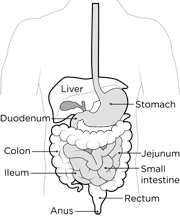How the Liver Works

The liver is the largest organ in the body.
It is located in the upper-right side of your child’s abdomen under the ribs and has a right lobe and a left lobe.
Nearly all of the blood that leaves the stomach and intestines must pass through the liver.
- Blood enters the liver through the hepatic artery and the portal vein.
- The blood from the hepatic artery carries oxygen and helps support liver growth.
- The portal vein carries blood and nutrients from the intestine and delivers them to the liver cells (hepatocytes), which perform specific liver functions.
- Blood leaves the liver through the hepatic veins.
The liver can regenerate naturally – as little as 25% of a liver can grow into a whole liver again. This is why surgeons can perform living-donor liver transplants, split-liver transplants and reduced-size liver transplants.
What does the liver do?
The liver performs several important functions:
- Filters and cleans the blood, removing impurities and toxins
- Helps digest food and metabolize (break down and use or store) substances that your child’s body takes in
- Stores energy for when the body needs it
- Helps fight infections
This organ is the body’s largest chemical factory. It produces many substances, including:
- Glucose, a basic sugar and energy source
- Proteins, the building blocks for growth
- Blood-clotting factors that aid in healing wounds
- Bile, a fluid stored in the gallbladder that the body needs to absorb fats and vitamins
What happens when the liver does not work well?
When the liver is not working well, all of its important functions are disrupted. Other organs, such as the kidneys and the brain, can be affected too.
